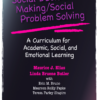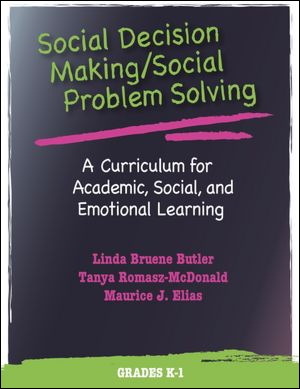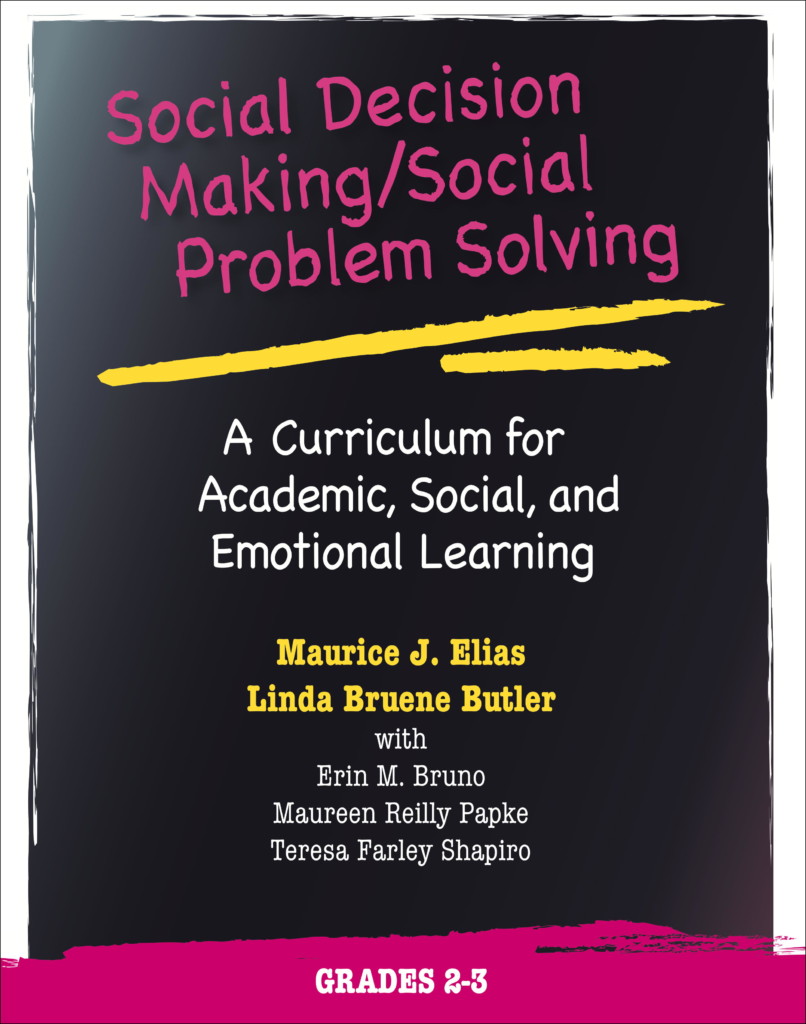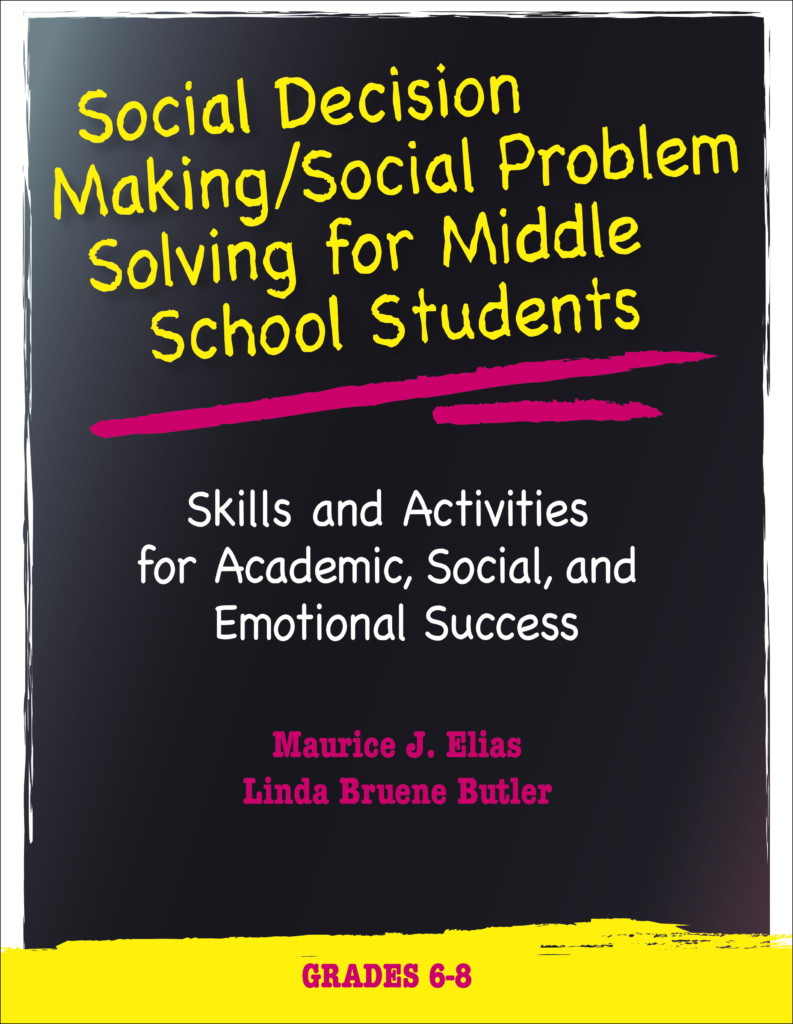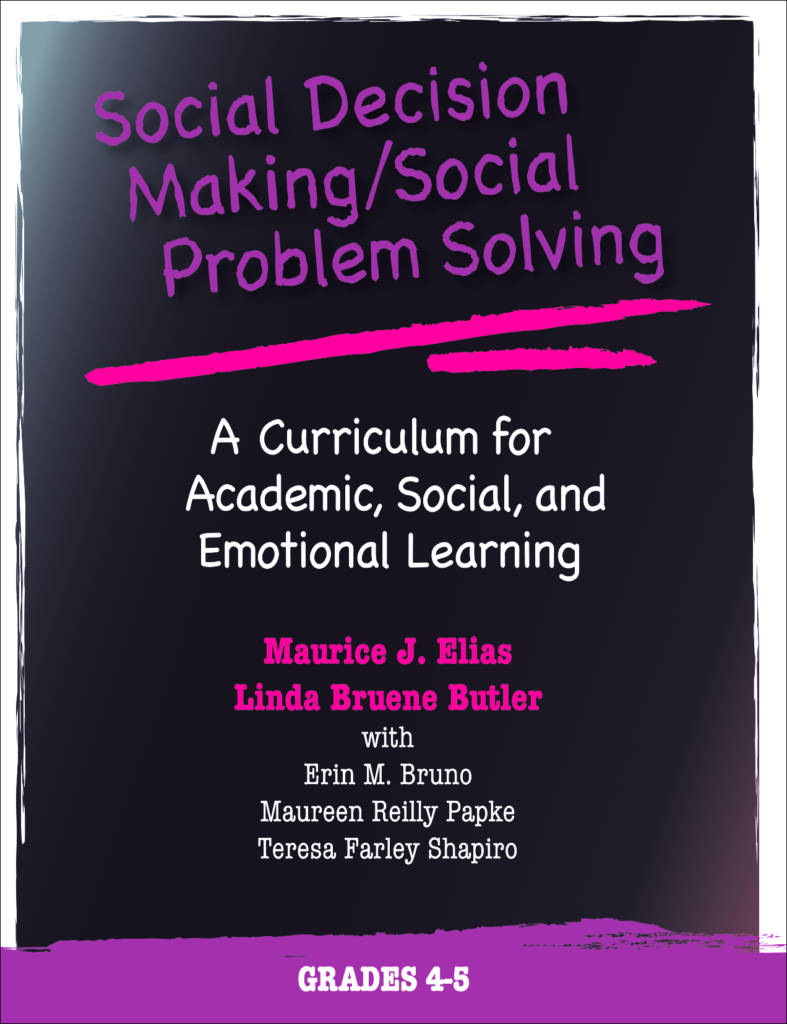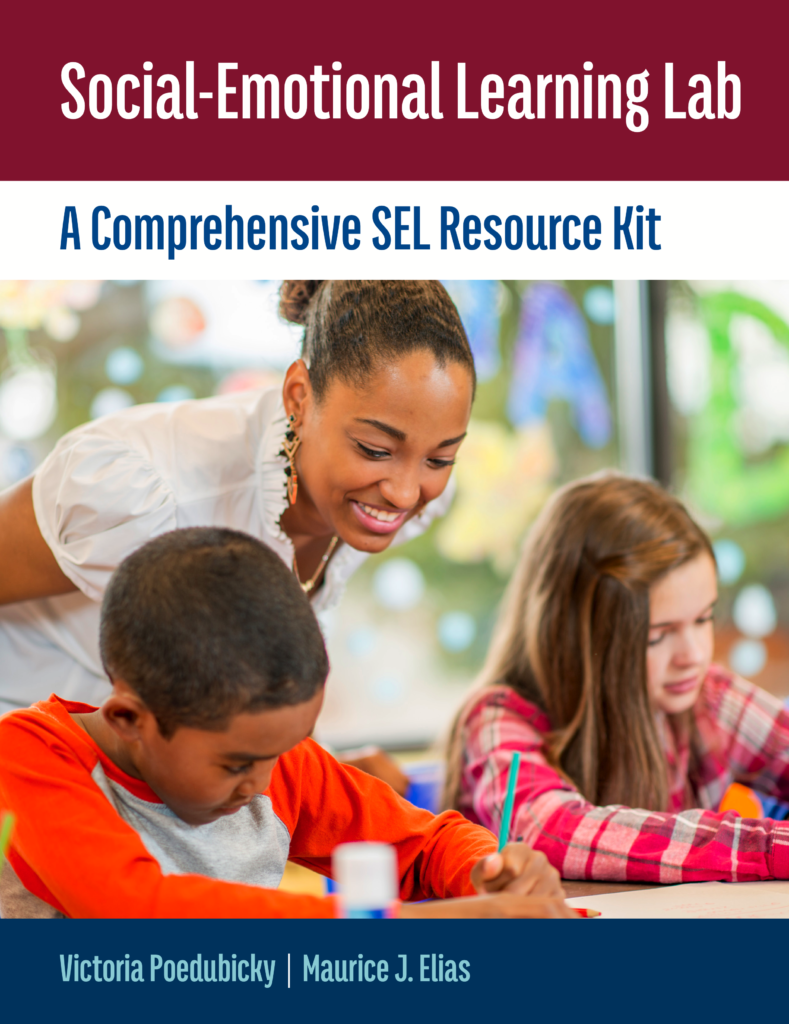SELect PROGRAMS
The designation indicates that a program is evidence-based; well-designed and classroom-based program that systematically promotes students’ social and emotional competence, provides opportunities for practice, and offers multiyear programming; and delivers high-quality training and other implementation supports.
Developed over three decades of implementation in a wide range of schools, this research-validated curriculum focuses on teaching students to be reflective, nonimpulsive, and responsible decision makers and problem solvers—while emphasizing essential literacy skills. It is ideal for classroom use and can be adapted for small-group settings.
The program uses a variety of cooperative learning methods, including small-group brainstorming, problem-solving, and role-playing activities. Students learn skills such as self-control, listening, respectful communication, giving and receiving help, and working cooperatively and fairly in groups. The manual includes numerous reproducible worksheets available as a download.
SDM/SPS influences student behavior, academic learning, and social and emotional life. It promotes a multicultural perspective by building group cohesion, acceptance of differences, and the ability to understand different points of view.
SDM/SPS has been recognized as:
- an Exemplary Evidence-Based Social-Emotional Learning Program by CASEL (Collaborative for Academic, Social, and Emotional Learning)
- a Statewide Model Program for Substance Abuse Prevention by the New Jersey State Department of Education
- a Promising Program by the Expert Panel, U.S. Department of Education Office of Safe and Drug-Free Schools
- an Exemplary Evidence-Based, School-Based Learning Program by NASP (the National Association of School Psychologists)
Separate volumes of the SDM/SPS curriculum are available for grades K–1 and 2–3. As an ideal extension of the elementary curriculum, the authors have also written an SDM/SPS manual for working with middle school students.
Book Review
“Using strategies such as metacognition, practice exercises, self-talk, body awareness, and aligning these topics with academic subjects to maximize generalization, this work brings the best and latest research for teaching students how to navigate complex interpersonal and intrapersonal challenges. . . . SDM/SPS for any of the grade levels will be valuable for those making the leap to classroom guidance and want a well rounded program that addresses social, academic, and mood management skills.”
—Lynn Merlone, NH School Counselor Newsletter
Training and Workshops
In-service training, consultation, or workshops by the developers of the SDM/SPS program can be provided for your school, facility, or organization. For more information and available dates, please contact:
Rutgers University Behavioral Health Care Behavioral Research and Training Institute
151 Centennial Avenue
Suite 1140
Piscataway, NJ 08854
Phone: (732)-235-9280
E-Mail: spsweb@ubhc.rutgers.edu
Website: www.ubhc.rutgers.edu/sdm/services
Introduction: Guide to Instructional Design and Implementation Procedures
Recommended Topics for Grade 4
Rules and Tools
- Introduction to Social Decision Making/Social Problem Solving (SDM/SPS) Lessons
- Respectful Listening
- Strategies for Remembering
- Role-Playing
- Be Your BEST
- BEST Applied: Good Teammate Behaviors
- BEST Applied: Giving and Receiving Praise
- Packing Your SDM/SPS Toolbox
Emotional Regulation
- Trigger Situations and Feelings Fingerprints
- Keep Calm
- Practice Keep Calm and Be Your BEST
- Be Your BEST and Trigger Journal
- More Tools for the Toolbox
Social Decision Making and Social Problem Solving
- Introducing FIG TESPN
- FIG TESPN: Step 1. F = Find the Feelings
- FIG TESPN: Step 2. I = Identify the Problem
- FIG TESPN: Step 3. G = Guide Yourself with a Goal
- Giving Constructive Criticism: Find the Feelings, Identify the Problem, and Guide Yourself with a Goal (FIG)
- FIG TESPN: Step 4. T = Think of Many Possible Solutions
- FIG TESPN: Step 5. E = Envision Consequences
- FIG TESPN: Step 6. S = Select the Best Solution
- FIG TESPN: Step 7. P = Plan and Be Prepared for Pitfalls
- FIG TESPN: Step 8. N = Notice What Happened (Now What?)
- FIG TESPN: Putting It All Together-Teacher-Led Problem-Solving Practice
- FIG TESPN: Practicing Problem Solving-Find Your Strengths
- Review SDM/SPS Tools and Celebrate Success
Supplemental
- Solving the Problem of Moving to a New Grade or School
- Using FIG TESPN to Tame Tough Topics
- Using FIG TESPN to Plan Community Service Activities
- Using FIG TESPN as a Book Report Guide
Grade 4 Worksheets
- Listening Position
- Respectful Listening
- Be Your BEST
- Be Your BEST Grid
- Sample Be Your BEST Grid
- What Makes a Good Teammate?
- Giving Praise
- I’m a Star!
- Tools for the SDM/SPS Toolbox (Topics 1-7)
- Checking Your SDM/SPS Tools (Topics 1-7)
- Keep Calm
- Keep Calm Reminder Cards
- Trigger Journal
- Tools for the SDM/SPS Toolbox (Topics 9-12)
- Checking Your SDM/SPS Tools (Topics 9-12)
- FIG TESPN Ladder
- Feelings Flashcards
- Feelings, Problems, and Goals
- Giving Constructive Criticism
- I-Messages
- FIG TESPN: Eight Steps for Social Decision Making and Social Problem Solving
- Plan and Be Prepared for Pitfalls
- Personal Problem-Solving Planner
- SDM/SPS Tools (Topics 14-25)
- Certificate of Achievement
- Student Progress Report
- SDM/SPS Summary and Recommendations
- Here Today, There Tomorrow
- Action Plan
- Taming Tough Topics
- Book Report Guide
Recommended Topics for Grade 5
Social Decision Making and Social Problem Solving
- Introduction to Social Decision Making/Social Problem Solving (SDM/SPS) Lessons
- Introduction to FIG TESPN
- Feelings Identification
- Trigger Situations and Physical Signs of Stress
- Keep Calm
- Identify the Problem
- Trigger Journal
- Guide Yourself with a Goal
- Understanding Different Points of View
- Think of Many Solutions and Envision Consequences
- Practice Thinking of Solutions and Envisioning Consequences
- Your BEST Chance for Success
- Select the Best Solution, Then Plan and Prepare for Pitfalls
- Notice What Happened (Now What?)
- Problem Solving: Using All the FIG TESPN Steps
Putting It All Together
- Using FIG TESPN with Literature
- Using FIG TESPN with Literature
- Using FIG TESPN for Creative Writing
- Using FIG TESPN to Critically Examine Stories and Media Reports
- Using FIG TESPN to Critically Examine Advertising
- Using FIG TESPN to Solve Problems in Science
- Using FIG TESPN to Examine Problems in History
- Using FIG TESPN to Think About Fairness and Prejudice
- Using FIG TESPN to Make Decisions and Solve Problems in Our Lives
- Using FIG TESPN to Prepare for a Test
- Review SDM/SPS Skills and Celebrate Our Strengths
Supplemental
- Using FIG TESPN to Change Target Behaviors
- Using FIG TESPN in Student Government
- Using FIG TESPN to Understand and Analyze Current Events
Grade 5 Worksheets
- Listening Position
- Respectful Listening
- FIG TESPN
- Keep Calm
- Trigger Journal
- My Goals
- What Could This Be?
- FIG TESPN: Eight Steps for Social Decision Making and Social Problem Solving
- Be Your BEST
- Be Your BEST Grid
- Personal Problem-Solving Planner
- Literature Discussion Guide
- Creative Thinking for Creative Writing
- Using Decision Making to Examine Your Writing
- What’s in a Story?
- Media Literacy Assignment
- Commercial Analysis
- Using Science to Solve Problems
- Events in History
- Complete the Sentences
- Being Fair to Others
- Testing Feelings
- SDM/SPS Skills: Grade 5
- Certificate of Achievement
- Student Progress Report
- SDM/SPS Summary and Recommendations
- Taking a Look at Myself
- Student Government Survey
- Current Events
Tables
- Skills Taught in SDM/SPS Curriculum: Grades 2-8
- Social Decision Making/Social Problem Solving (SDM/SPS): Academic and Home Application Activities (Grade 4)
- Social Decision Making/ Social Problem Solving (SDM/SPS): Academic and Home Application Activities (Grade 5)
- Summary of Change in Teachers’ Inhibitory and Highly Facilitative Responses Following SDM/SPS Training
- Summary of Mean Competence Scores and Statistics from the Three Studies of the Readiness Phase of the Curriculum
- Change in Fourth Graders’ Mean Interpersonal Sensitivity (I.S.), Problem Analysis (P.A.), and Planning (PLAN) Scores Following Training in the Instructional Phase of SDM/SPS
- Change in Mean Scores for Interpersonal Sensitivity (I.S.), Problem Analysis (P.A.), and Planning (PLAN) by Grade: Bloomfield
- Correlations Between GSPSA Subscales and Survey of Middle School Stressors and Piers-Harris Scores for the Experimental Group
- Experience of High School Follow-Up Group
Appendixes
- The SDM/SPS Curriculum Approach: Evidence of Effectiveness
- Tools for Program-Level Assessment
Outcome Data: Four major evaluation studies have been conducted in 1986, 1991, 1997 and 2007 in additional to a wide range of additional evaluations nationally and internationally.
In the video below, Research Press author Maurice Elias discusses the positive impact of promoting social emotional learning (SEL) and character development with Christopher De Michele at Rutgers University (you may also view the 48-minute interview and discussion at vimeo.com):
Reproducible forms and handouts for this title are available on our downloads page.



